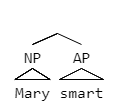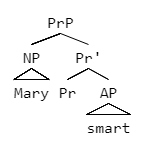User:Csstudent300/sandbox
X-Bar Theory Structure
[edit]See X-Bar Theory for a general explanation of X-Bar Theory.
X-bar theory predicts that a head (X) will project into an intermediate constituent (X') and a maximal projection (XP). There were three common analyses of the internal structure of a small clause under X-Bar theory[1]. Here they are each presented as showing the NP AP small clause complement in the sentence (highlighted in bold), "I consider (NP)Mary (AP)smart":
The small clause as a symmetric constituent
In this analysis, neither of the constituents determine the category, meaning that it is an exocentric construction. Some linguists believe that the label of this structure can be symmetrically determined by the constituents[2][3], and others believe that this structure lacks a label altogether[4]. In order to indicate a predicative relationship between the subject (in this case, the DP Mary), and the predicate (AP smart), some have suggested a system of co-indexation, where the subject must c-command any predicate associated with it.[5]
This analysis is not compatible with X-bar theory because X-bar theory does not allow for headless constituents, additionally this structure may not be an accurate representation of a small clause because it lacks an intermediate functional element that connects the subject with the predicate. Evidence of this element can be seen as an overt realization in a variety of languages such as Welsh[6], Norwegian[7], and English, as in the examples below[6] (with the overt predicative functional category highlighted in bold):
- I regard Fred as insane.
- I consider Fred as my best friend.
Some have taken this as evidence that this structure does not adequately portray the structure of a small clause, and that a better structure must include some intermediate projection that combines the subject and the predicate[8] which would assign a head to the constituent.
The small clause as a projection of the predicate
In this analysis, the small clause can be identified as a projection of the predicate (in this example, the predicate would be the 'smart' in 'Mary smart'). In this view, the specifier of the structure (in this case, the NP 'Mary') is the subject of the head[9] (in this case, the A 'smart'). This analysis builds on Chomsky's[10] model of phrase structure and is proposed by Stowell[11] and Contreras[12].
The small clause as a projection of the functional category
The PrP[13] (predicate phrase) category (also analyzed as AgrP[7], PredP[14], and P[9]), was proposed for a few reasons, some of which are outlined below:
- This structure helps to account for coordination where the categories of the items being coordinated must be the same. This accounts for the mystery of phrases such as example 1 below, where in the bolded small clause an adjective phrase (AP) is being coordinated with a noun phrase (NP), and it still has a grammatical reading. The addition of the PrP category helps to solve this issue by positing that the items being coordinated are under the intermediate projection of the Pr head, the Pr', as seen in example 2[9].
- Mayor Shinn considered Eulalie (AP)talented and (NP)a tyrant.
- Mayor Shinn considered (PrP)Eulalie (Pr')(P) (AP)talented and (Pr')(P) (NP)a tyrant.
- This structure answers the question of the category of the word 'as' in small clause constructions such as "I regard Fred as my best friend". This structure was an issue because 'as' could only be analyzed as a prepositional phrase, but prepositions do not take adjective phrase complements. Analyzing 'as' as an overt realization of the Pr head, then the small clause structure under X-bar theory can be upheld[13].
Additionally, some have theorized that a combination of the three structures can illustrate why the subjects of verbal small clauses and adjectival small clauses seem to behave differently, as noted by Basilico[15]:
- The prisoner seems/appears to be intelligent.
- The prisoner seems/appears intelligent.
- The prisoner seems/appears to leave every day at noon.
- *The prisoner seems/appears leave every day at noon.
Here, examples 1 and 2 show that adjectival small clauses are allowed to be raised to the matrix subject position (example 1 is in situ, and example 2 has been raised) but the same cannot be done to a verbal small clause in examples 3 and 4, where the * marks ungrammaticality. From this evidence, some linguists have theorized that the subjects of adjectival and verbal small clauses must differ in syntactic position. This conclusion is bolstered by the knowledge that verbal and adjectival small clauses differ in their predication forms. Adjectival small clauses involve categorical predication where the predicate ascribe a property of the subject, and verbal small clauses involve thetic predications, where an event that the subject is participating in is reported[4]. Basilico uses this to argue that a small clause should be analyzed as a Topic Phrase, which is projected from the predicate head (the Topic), where the subject is the specifier[1]. In this way, he argues that in an adjectival small clause, the predicate is formed for an individual topic, and in a verbal small clause the events form a predicate of events for a stage topic, which accounts for why verbal small clauses cannot be raised to the matrix subject position[16]
- ^ a b Citko, Barbara (2011). "Small Clauses: Small Clauses". Language and Linguistics Compass. 5 (10): 752. doi:10.1111/j.1749-818X.2011.00312.x.
- ^ Pereltsvaig, Asya (2008). Copular Sentences in Russian: A Theory of Intra-Clausal Relations. Springer Science. pp. 47–49. ISBN 978-1-4020-5794-6.
- ^ Citko, Barbara (2011). Symmetry in Syntax: Merge, Move and Labels. Cambridge University Press. pp. 176–178. ISBN 978-1107005556.
- ^ a b Moro, Andrea. (2008). The anomaly of copular sentences. Unpublished manuscript, University of Venice.
- ^ Williams, Edwin (Winter 1980). "Predication" (PDF). Linguistic Inquiry. 11 (1) (1 ed.): 204. JSTOR 4178153 – via JSTOR.
- ^ a b Bowers, John (2001-01-01), Baltin, Mark; Collins, Chris (eds.), "Predication", The Handbook of Contemporary Syntactic Theory, Blackwell Publishers Ltd, p. 310, doi:10.1002/9780470756416.ch10, ISBN 9780470756416, retrieved 2019-04-18
- ^ a b Eide, Kristin M.; Åfarli, Tor A. (1999). "The Syntactic Disguises of the Predication Operator". Studia Linguistica. 53 (2): 160. doi:10.1111/1467-9582.00043. ISSN 0039-3193.
- ^ Citko, Barbara (2011). "Small Clauses: Small Clauses". Language and Linguistics Compass. 5 (10): 748–763. doi:10.1111/j.1749-818X.2011.00312.x.
- ^ a b c Balazs, Julie E. (2012). The Syntax of Small Clauses. pg. 23. Masters Thesis, Cornell University.
- ^ Chomsky, Noam (1970). "Remarks on nominalization". In Jacobs, Roderick; Rosenbaum, Peter (eds.). Readings in English Transformational Grammar. Georgetown University School of Language. pp. 170–221. ISBN 978-0878401871.
- ^ Stowell, Timothy A. "Origins of phrase structure". DSpace@MIT. hdl:1721.1/15626.
- ^ Contreras, Heles (1987). "Small clauses in Spanish and English". Natural Language and Linguistic Theory. 5 (2): 225–243. doi:10.1007/BF00166585. ISSN 0167-806X. S2CID 170111841.
- ^ a b Bowers, J. (1993). The Syntax of Predication. Linguistic Inquiry,24(4), pg. 596-597. Retrieved from http://www.jstor.org/stable/4178835
- ^ Bailyn, J. F. (1995). A Configurational Approach to Russian ‘Free’Word Order. Unpublished doctoral dissertation, Cornell University, Ithaca.
- ^ Basilico, D. (2003). The Topic of Small Clauses. Linguistic Inquiry,34(1), pg. 2. Retrieved from http://www.jstor.org/stable/4179219
- ^ Basilico, David (2003). "The Topic of Small Clauses". Linguistic Inquiry. 34 (1): 9. doi:10.1162/002438903763255913. ISSN 0024-3892. JSTOR 4179219. S2CID 57572506.





